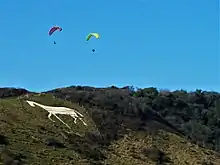Litlington White Horse
The Litlington White Horse is a chalk hill figure depicting a horse, situated on Hindover Hill in the South Downs, looking over the River Cuckmere to the west of the village of Litlington and north of East Blatchington in East Sussex, England. The current horse was cut in 1924 by John T, Ade, Mr. Bovis and Eric Hobbis in a single night and stands at 93 feet long and 65 feet high. A previous horse was cut in either 1838 or 1860 on the same site.[1] Since 1991, the horse has been owned by the National Trust, who regularly clean and maintain the horse along with local volunteers.[2]

Original Litlington White Horse
The origin and date of the original White Horse is debated. One view is that it was created by a James Pagden of Frog Firle Farm, along with his two brothers, in 1838 to commemorate the coronation of Queen Victoria. Another view is that the horse was cut in 1860 by two local boys: noticing a patch of bare chalk resembling a horse's head, they proceeded to cut away the rest of the horse to complement it.[3]
Current White Horse
The current horse was carved by John T. Ade, Mr. Bovis, and Eric Hobbis in one night in 1924. One of these men is thought to have been a descendant of the original horse's creator. During a full moon, the men cut the horse without the knowledge of the local residents, who awoke startled by the horse's appears on the side of the hill; this may have been the motivation behind the speedy cutting.[4]
The horse has since been maintained by local residents, although it was covered in the late 1930s so as to prevent it being used as a location marker for the Luftwaffe in World War II. The uncovering of the horse after 1945 resulted in several changes to the horse's original shape, with only one leg being recut.[5] In the late 1980s, the East Sussex County Council scoured the horse. It was at this time that the horse was changed from a standing position to a prancing position, in order to prevent a slippage of chalk rubble used to fill the figure.[6]
See also
Other white horses
Other hill figures
References
- "Litlington White Horse". Atlas Obscura. Atlas Obscura.
- "Littlington White Horse". Litlington White Horse. Littlington White Horse. Retrieved 14 September 2020.
- "Litlington White Horse". Atlas Obscura. Atlas Obscura.
- "Littlington White Horse". Littlington White Horse. Littlington White Horse. Retrieved 14 September 2020.
- "Littlington White Horse". Littlington White Horse. Littlington White Horse. Retrieved 14 September 2020.
- "Littlington White Horse". Littlington White Horse. Littlington White Horse. Retrieved 14 September 2020.
